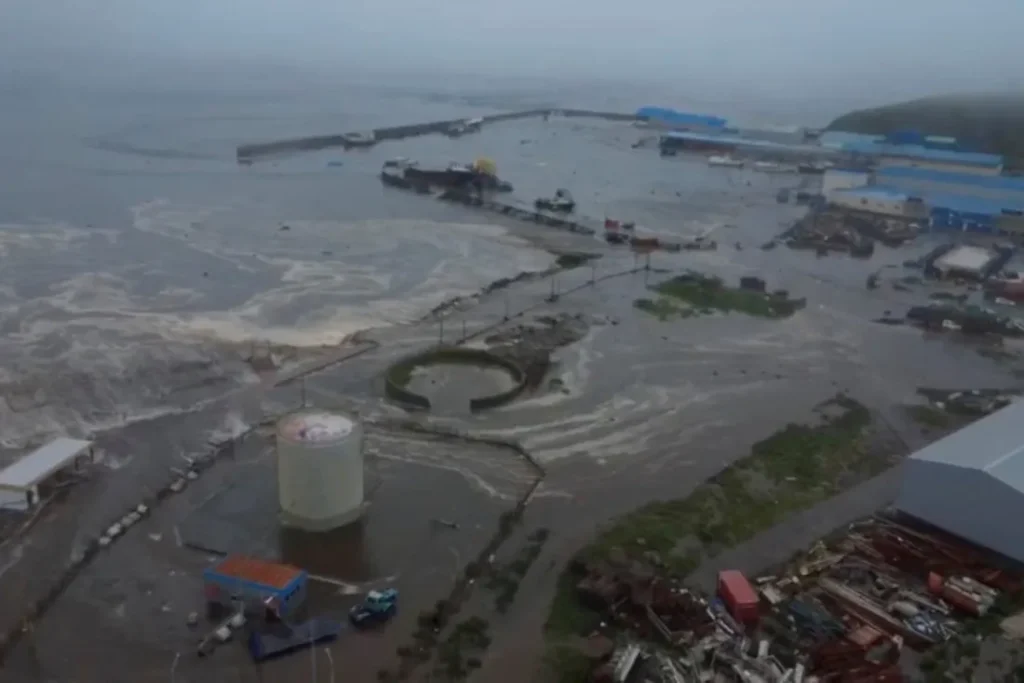By [Tushar Mehta], International Affairs Correspondent
In the early hours of Tuesday morning, seismic tremors jolted the Pacific Rim, sending shockwaves—both geological and political—across the globe. A massive earthquake measuring 8.6 on the Richter scale struck 120 kilometers off the coast of the Solomon Islands, triggering immediate tsunami alerts across several Pacific nations, including Japan, New Zealand, Papua New Guinea, and even parts of the U.S. West Coast.
While initial reports indicated a tsunami wave of up to 3 meters in height, emergency systems quickly went into action to evacuate low-lying regions. No fatalities have been confirmed as of this writing, though property damage in parts of the Solomon Islands and Vanuatu is being assessed. The event, however, has reignited a broader discussion about climate preparedness, the efficacy of international disaster response frameworks, and the vulnerability of island nations in an era of accelerating environmental instability.
🌍 The Ring of Fire Strikes Again

The Pacific Ring of Fire—an arc of seismic activity that stretches from Southeast Asia to the Americas—has long been one of the most geologically volatile regions on Earth. However, the increasing frequency and intensity of such events have prompted geologists and climate scientists to raise alarms.
Dr. Melissa Ortega, a geophysicist at the University of California, stated in an exclusive interview:
“While tectonic movements are natural and have been occurring for millennia, the climate crisis is exacerbating their after-effects. Rising sea levels mean tsunamis can travel farther inland. Urban sprawl along coastlines makes the potential for damage even greater.”
🌐 International Response and Gaps
The Pacific Tsunami Warning Center (PTWC) based in Hawaii issued alerts within minutes of the quake. Japan’s meteorological agency and New Zealand’s civil defense quickly followed suit. In many coastal towns across Oceania, sirens blared as people fled inland—some on foot, others by car.
Yet, as always, the poorest and most remote communities were the slowest to receive alerts. The digital divide and lack of infrastructure once again exposed critical vulnerabilities.
UN Secretary-General António Guterres released a statement praising the swift response but emphasized the need for more inclusive systems:
“Technology must serve every citizen. Remote islanders and indigenous communities should not be the last to know when disaster is coming.”
The World Bank and IMF have also been urged to prioritize disaster-resilience funding for smaller nations, especially in Oceania, where both infrastructure and insurance frameworks are woefully inadequate.
🏘️ Climate Change and Tsunami Preparedness
While earthquakes themselves are not caused by climate change, their deadly aftermath often is worsened by rising sea levels and extreme weather. Coastal erosion, coral bleaching, and warmer ocean temperatures all amplify the risk of devastation.
The 2004 Indian Ocean tsunami, which killed over 230,000 people across 14 countries, remains a grim reminder of what happens when the global community is caught unprepared.
Today, the question isn’t just about responding to tsunamis—but preparing for them in a changing world.
Dr. Latu Moana, a climate scientist from Fiji, argues:
“Island nations are at the frontlines of both tectonic and climatic disasters. The world must view their plight not as isolated events, but as early warnings of what’s to come globally.”
🛰️ Tech in Tsunami Detection: Room to Improve
Despite technological advances, real-time tsunami detection remains patchy. The Deep-ocean Assessment and Reporting of Tsunamis (DART) system, for instance, is not universally deployed. And even when it is, maintaining underwater sensors across thousands of kilometers of ocean floor is both expensive and technically challenging.
India, Japan, and the United States have invested heavily in early-warning systems. However, collaborative data sharing—especially with smaller countries—remains inconsistent. In a world where seconds can mean the difference between life and death, better international cooperation could save thousands.
🌐 Looking Ahead
This earthquake may not have caused mass casualties, but it was a loud reminder of how vulnerable the Pacific remains. It calls for a renewed focus on regional collaboration, early-warning systems, sustainable infrastructure, and international funding for disaster-prone areas.
Global leaders are set to meet at the UN Disaster Risk Reduction conference in Geneva next month. The agenda has now shifted, with Pacific safety likely taking center stage. Whether this disaster will catalyze meaningful global change—or merely become another footnote—remains to be seen.
For now, islanders return home, thankful to have survived. But the ground beneath their feet—and the seas around them—remain as unpredictable as ever.
